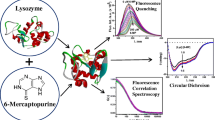Abstract
WhenLeishmania donovani promastigote forms, were cultured in TC-199 medium at 28°C and subsequently incubated at 38°C, they turned into aflagellate (amastogote-like) forms. A return of the incubation-culture temperature to 28°C these amastigote-like forms to revert to promastigotes. The amastigotes obtained by heat-shock, were viable and retained antigenic capacity being recognized by the sera of naturally infected patients. These forms, remained also capable of multiplying inside the J-774A. 1 macrophages. When the amastigote-like forms are kept in culture at 38°C retained their rounded appearance and their biological characteristics for more than 3 months subculturing every 6 days. These amastigote-like forms, when used for subcultures at 28°C, transformed into promastigotes capable of multiplying, as flagellate forms. The amastigotelike forms obtainedin vitro can be used in biochemical studies related to chemotherapy and immunology studies, as part of an effort to combat this parasite. The end-products of of glycolysis were studied in both the amastigote-like and promastigote forms ofL. donovani, by proton magnetic resonance analysis of the culture media. Alanine, succinate, and acetate, were predominant, and to a lesser extent pyruvate, glycine and D-lactate. Our results suggest that both forms ofLeishmania use different biochemical strategies to obtain their energy.
Similar content being viewed by others
References
Alexander J, Vickerman K: Fusion of host cell secondary lysosomes with parasitophorous vacuoles ofLeishmania mexicana-infected macrophages. J Protoz 22: 502–508, 1975
Chang KP, Dwyer DM: Multiplication of a human parasite (Leishmania donovani) in phagolysosomes of hamster macrophagesin vitro. Science 193: 678–680, 1976
Pan AA:Leishmania mexicana: Serial cultivation of intracellular stages in a cell-free medium. Exp Parasit 58: 72–80, 1984
Smejkal RM, Geller R, Hansen BD, Olenick JG: A two-dimensional gel electrophoresis analysis of the conversion ofLeishmania brasiliensis panamensis promastigotes to amastigotes forms. Fed Proc 43: 1791–1795, 1984
Lawrence F, Robert-Gero M: Induction of heat shock and stress proteins in promastigotes of threeLeishmania species. Proc Natl Acad Science 82: 4414–4417, 1985
Darling TN, Blum JJ:In vitro reversible transformation ofLeishmania brasiliensis panamensis between promastigotes and ellipsoidal forms. J Protoz 34: 166–168, 1987
Stinson S, Sommer JR, Blum JJ: Morphology ofLeishmania brasiliensis: Change during reversible heat-induced transformation from promastigotes to an ellipsoidal form. J Parasit 75: 431–440, 1989
Pan AA:Leishmania mexicana pifanoi: Analysis of antigenic relationships between promastigotes and amastigotes by gel diffusion, immunoelectrophoresis, and immunoprecipitation. J Protoz 33: 192–197, 1986
Smejkal RM, Wolff R, Olenick JG:Leishmania brasiliensis panamensis: Increased infectivity resulting from heat shock. Exp Parasit 65: 1–9, 1988
Eperon S, McMahon-Pratt D: Extracellular cultivation and morphological characterization of amastigote like forms ofLeishmania panamensis andLeishmania brasiliensis. J Protoz 36: 502–510, 1988a
Eperon S, McMahon-Pratt D: Extracellular amastigote-like forms ofLeishmania panamensis andLeishmania brasiliensis. Stage- and species-specific monoclonal antibodies. J Protoz 36: 510–518, 1988b
Doyle PS, Engel JC, Pimenta PFP, Da Silva PP, Dwyer DM:Leishmania donovani: Long-term Culture of Axenic Amastigotes at 37°C. Exp Parasit 73: 326–334, 1991
Gamarro F, Osuna A, Castanys S, Perez-Lopez MI, Ruiz-Perez LM: Isolation and purification of amastigotes ofTrypanosoma cruzi from cultured Vero cells. Zeitschrift für Parasitenkunden 71: 15–17, 1985
Hames BD: An introduction to polyacrylamide gel electrophoresis. In Gel electrophoresis of proteins: a practical approach, BD Hames and D Rickwood (eds), IRL Press, London, Washington DC, pp 6–14, 1981
Bergmeyer HU: Methods of Enzymatic Analysis, 2nd edn., Academic Press, New York, 1974
Molyneux, DH, Killick-Kendrick R: Morphology, ultrastructure and life cycles. Academic Press, London, pp 121–176, 1987
Kar K, Mukerji K, Naskar K, Bhattacharya A, Ghosh DK:Leishmania donovani: A chemically defined medium suitable for cultivation and cloning of promastigotes and transformation of amastigotes to promastigotes. J Protoz 37 (4): 277–279, 1990
Chang KP, Hendricks LD: Laboratory cultivation and maintenance ofLeishmania. In KP Chang and RS Bray (eds) Elsevier Science Publishers B.V. (Biomedical Division). New York, pp 213–244, 1976
Zilberstein D, Blumenfeld N, Liveanu V, Gepstein A, Jaffe CL: Growth at acidic pH induces an amastigote stage-specific protein inLeishmania promastigotes. Mol Biochem Parasit 45: 175–178, 1991
Shapira M, Mcewab JC, Jaffe CL: Temperature effects on molecular processes which lead to stage differentiation inLeishmania. EMBO Journal 7: 2895–2901, 1988
Van Der Ploeg LHT, Giannini SH, Cantor CR: Heat shock genes: Regulatory role for differentiation in parasitic protozoa. Science. 228: 1443–1446, 1985
Keegan F, Blum JJ: Effects of oxygen concentration on the intermediary metabolism ofLeishmania major promastigotes. Mol Biochem Parasit 39: 234–246, 1990
Rainey PM, Mackenzie NE: A carbon-13 nuclear magnetic resonance analysis of the products of glucose metabolism inLeishmania pifanoi amastigotes and promastigotes. Mol Biochem Parasit 45: 307–316, 1991
Darling TN, Davis DG, London RE, Blum JJ: Metabolism interactions between glucose, glycerol, alanine, and acetate inLeishmania braziliensis panamensis promastigotes. J Protoz 36: 217–225, 1989
Cazzulo JJ, Cazzulo BMFD, Engel JC, Cannata JJB: End products and enzyme levels of aerobic glucose fermentation in trypanosomatids. Mol Biochem Parasit 16: 329–343, 1985
Hart DT, Coombs GH:Leishmania mexicana: energy metabolism of amastigotes and promastigotes. Exp Parasit 54: 397–309, 1982
Darling TN, Balber AE, Blum JJ: A comparative study of D-lactate, L-lactate and glycerol formation by four species ofLeishmania and byTrypanosoma lewisi andTrypanosoma brucei gambiense. Mol Biochem Parasit 30: 253–258, 1988
Simon MW, Martin E, Mukkada AJ: Evidence for a functional glyoxylate cycle in theLeishmaniae. J. Bacteriol 135: 895–899, 1978
Mukkada AJ: Energy metabolism inLeishmania. In: KP Chang, RS Bray (eds),Leishmaniasis, Elsevier, Amsterdam, pp 49–64, 1985
Hart DT, Opperdoes FR: The occurrence of glycosomes (microbodies) in the promastigote stage of four majorLeishmania species. Mol Biochem Parasit 13: 159–172, 1984
Author information
Authors and Affiliations
Rights and permissions
About this article
Cite this article
Castilla, J.J., Sanchez-Moreno, M., Mesa, C. et al. Leishmania donovani: In vitro culture and [1H] NMR characterization of amastigote-like forms. Mol Cell Biochem 142, 89–97 (1995). https://doi.org/10.1007/BF00928929
Received:
Accepted:
Issue Date:
DOI: https://doi.org/10.1007/BF00928929




